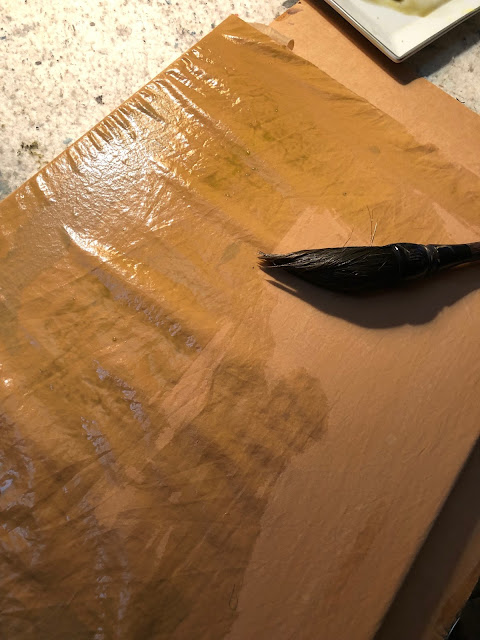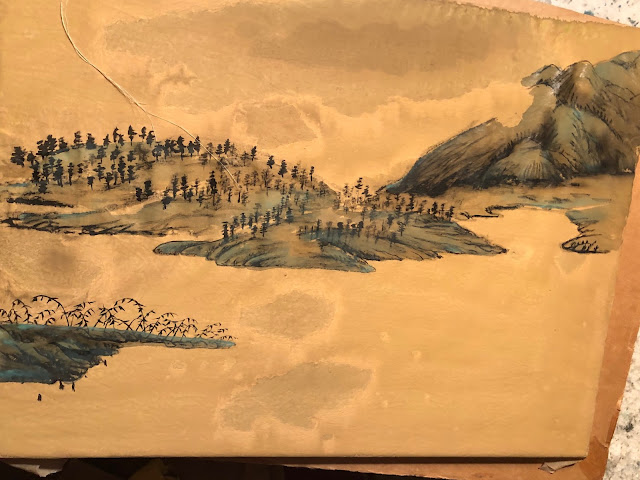To re-paint my painting. This time with a roof.
For some reason I really resend having to do anything over again, not only paintings. It is as if I was giving birth to something, whatever comes out is whatever I'll get. When I work on a project, I seem to give it all I have at the moment, albeit that it might not be enough. Perhaps I get bored rather easily, and can't bear to retrace my steps. I'll have to live with the finished product, regardless of whether it's a success or failure. Such is the bane of my life.
In order to re-invent this painting so that it will be fresh for me, I decided to start off with the background first. Which means I need to reserve the spaces for my protagonists.
I suppose in oil or drawing, one just sketch out the space and leave the designated area untouched. In watercolor I can use masking fluid, which is like a rubber cement and one could just paint over it. Unfortunately the Xuan that I use is like a glorified tissue and it cannot withstand the erasing, peeling of the dried film. I need to devise a way to save my voids.
So I was invigorated. I found something to tackle. I was no longer bored.
I sketched out the intended silhouette of my protagonists on paper. One of the changes I wanted to make in this new attempt was to align the clothing to the more authentic style of hanbok; making the "A" frame of the chima more Korean, and less of a skirt of the western flavor. My first attempt at sketching out the figure had all the proportions wrong. The body was too short. Perhaps I was reading the chima still at the waist level rather than at the bust level. I had to resort to the proportion of the body being approximately 7 and a half times the height of the head to double check myself. As you can see I ran out of paper.
I drew two silhouettes facing each other and cut them out such that I could stage them the way I wanted.
I then positioned them on my Xuan
In essence I was hoping that the paper cut-outs would function as my masking fluid. I could paint over them without violating the allotted space for my maidens.
I started with my support columns, knowing that a few of them juxtaposed with my maidens. These are the skeletons on which the flesh of the painting attach to.
I removed the cut-outs after the background architecture was finished. I was left with a void space in the shape of the silhouettes I fashioned.
The idea worked. I was definitely not bored.
So I proceeded to work on the hair and the bows and ribbons on the hair.
I finished dressing one girl, and decided to take a rest. I knew better to be headlong in the painting process. There need to be a fine balance between the creative drive and the calm examination. I had revealed my Id, now I wanted to give Ego a chance.
The critique I gave myself was that the girl looked too stiff. By that I meant the brushstroke, or rather the absence of brushstroke. The girl figure had a paint-by-number look to it. The space was filled in with color and not brushed in, giving it a rather uninteresting feel. Perhaps the fact that I was painting into a prescribed void left by my paper cut-out had something to do with it. Subconsciously I was following a outline, rather than a form. I became rather restricted.
Having diagnosed my own problem, I needed to paint the other girl with a more expressive brushstroke. That was the note I handed myself.
I also decided on assigning a more "traditional" color to her costume, at least the stereotype that was perpetuated to me. Again I am not trying to slight another culture by my own ignorance, I am just saying it.
I am hoping that you all agree with me that there was a lot more energy in the brushstroke for the girl on the right. Chinese brush is such an unforgiving tool. It can be so uncompromising, especially in exposing weaknesses.
By the time I painted in the shadows, the feet from the girl on the left disappeared. I did not handle to dark tones well on this part.
Perhaps I was being pedantic but it bothered me to no end that I had lost her feet. I would bet that nobody else but me would miss them feet. I just couldn't get over it. So I decided to put in light dabs of titanium white mixed with ink and gave a hint of something being present beneath the skirt.
I know. I am hopeless.



















































